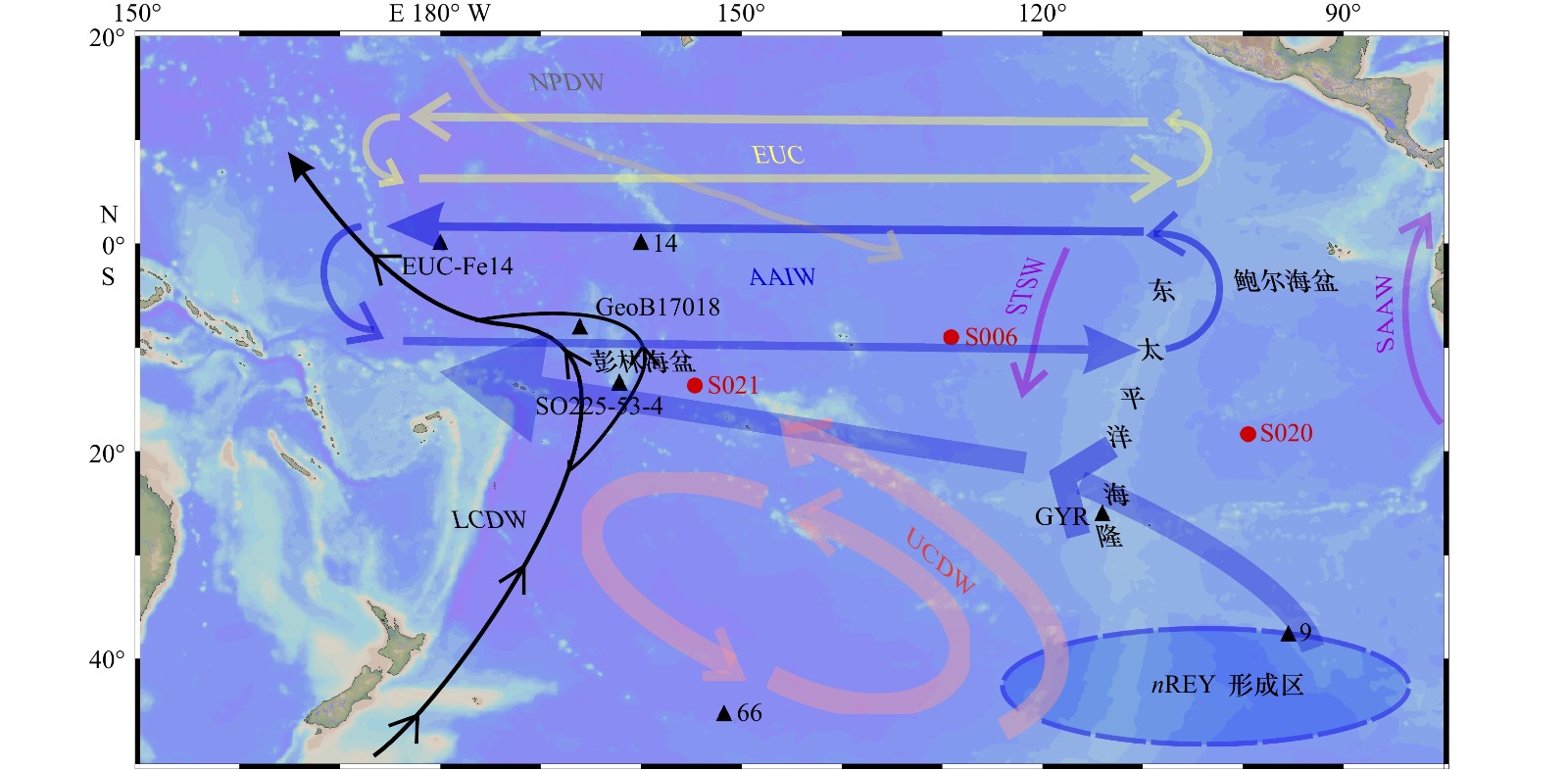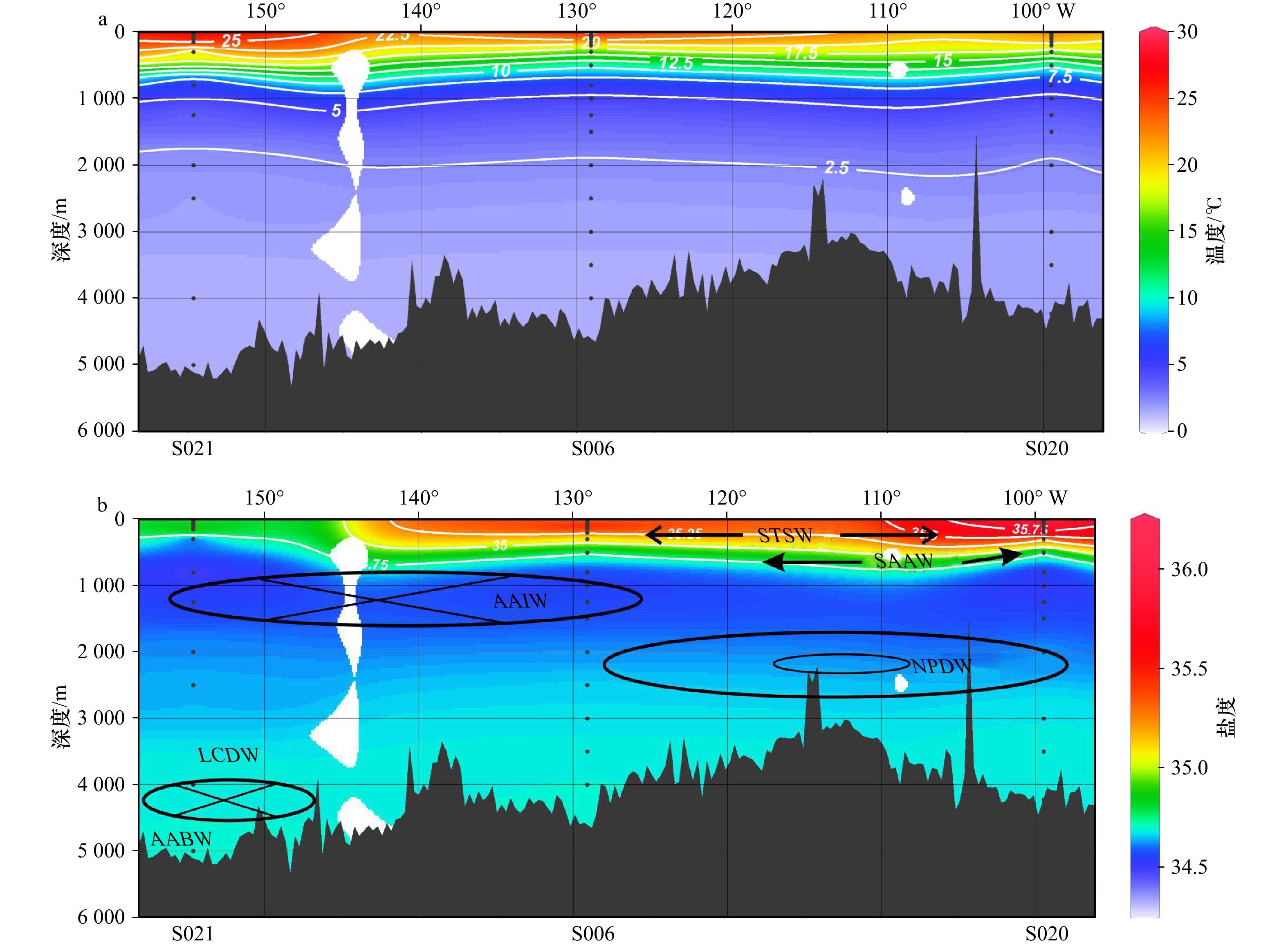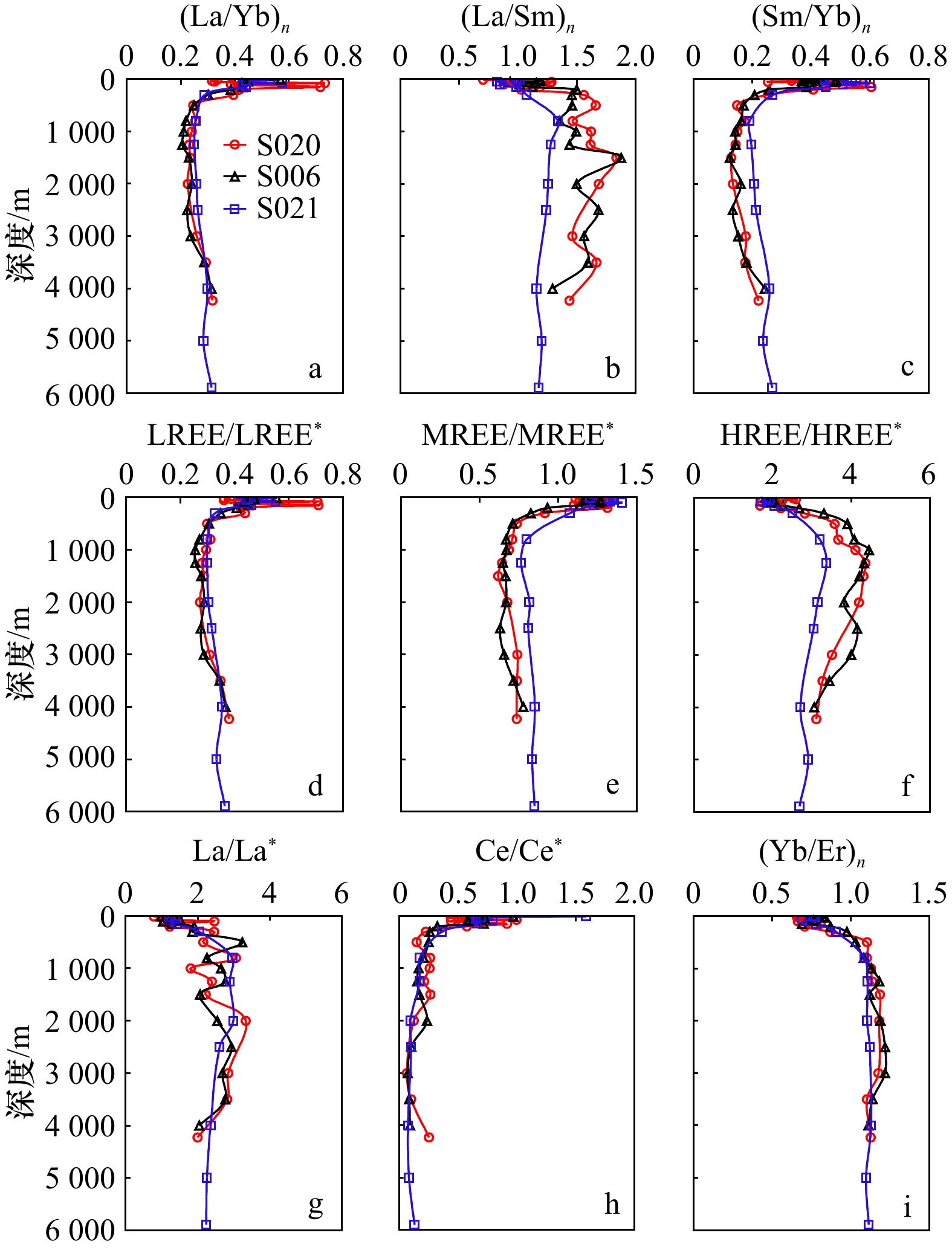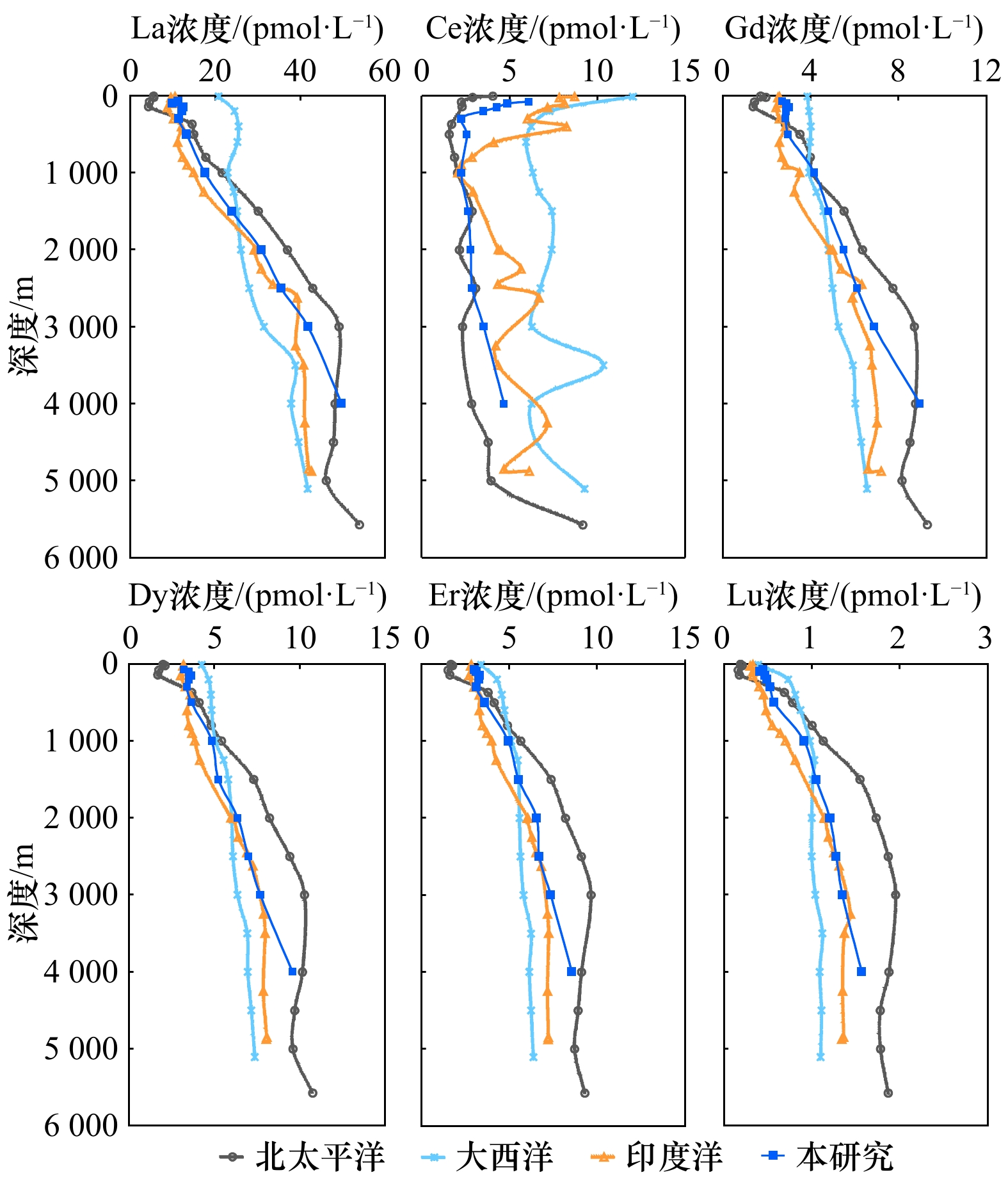The spatial distribution characteristics of dissolved rare earth elements in seawater of REY-enriched region in South Pacific Ocean
-
摘要: 深海富稀土沉积物因其资源潜力巨大,近年来备受关注。一般认为,沉积物中稀土元素和钇(总称REY)的主要来源为上覆海水,但针对富稀土海区上覆海水中REY的研究较少。本研究针对南太平洋富稀土海区采集的3个站位的全水深海水样品,测试出了15种溶解态REY,并对比了邻近海域已发表的数据,分析了该海区REY的空间分布特征。研究区表层水中溶解态REY浓度主要受风尘输入影响,而中层和深层水体中溶解态REY浓度主要受水团控制。经过澳大利亚后太古代页岩(PAAS)和北太平洋深层水(NPDW)归一化后的配分模式可确定REY间的分馏特征,分辨出不同水团。与其他大洋中报道的REY数据比较发现,表层水中REY浓度受风尘和河流输入影响导致差别较大,中层水中REY浓度与印度洋较为接近,深层水中REY浓度与不同大洋的水团年龄表现为正相关趋势,即REY浓度由小到大依次为大西洋、印度洋、南太平洋、北太平洋。Abstract: As potential mineral resources, rare earth elements and yttrium (REY)-rich sediments in deep-sea, have attracted a lot of attention in recent years. It is generally believed that the main source of REY should come from overlying seawater, but studies are in general lacking on the REY in overlying seawater in REY-enriched areas. In this paper, the dissolved concentrations and vertical distributions of 15 REY were studied in three stations located in the South Pacific Ocean, where enriched REY concentrations were found in sediments. Data obtained from this study were compared with data reported in adjacent waters and other ocean basins. The REY concentration in surface water of the study area was mainly controlled by wind-driven dust input, while the middle and deep waters were controlled by water masses. After the normalization of Post Achaean Australian Shale (PAAS) and North Pacific deep water (NPDW), the fractionation characteristics of REY can be clearly identified, and different water mass characteristics can be distinguished. When compared to data reported in other ocean basins and adjacent waters, more differences are found in surface waters due to dust and terrestrial inputs, while the REY concentrations in Indian Ocean are similar to the study region; the REY concentrations in deep water show a positive correlation with the age of water mass, i.e. the concentrations of REY from small to large are Atlantic, Indian Ocean, South Pacific, North Pacific.
-
图 1 南太平洋研究区站位及水团运移路径
STSW:亚热带表层水;SAAW:亚南极水;AAIW:南极中层水(由南向北);NPDW:北太平洋深层水(由北向南);LCDW:下环极深层水(由南向北);UCDW:上环极深层水;EUC:赤道潜流。水团分析参考自文献 [30-31];GeoB17018站位参考自文献[10];14站位参考自文献[13];EUC-Fe14站位参考自文献[30];SO225-53-4站位参考自文献[31];GYR站位参考自文献[32];9站位和66站位参考自文献[33]
Fig. 1 Station locations in South Pacific Ocean and water mass migration path in the study area
STSW: Subtropical Surface Water; SAAW: Subantarctic Water; AAIW: Antarctic Intermediate Water (from south to north); NPDW: North Pacific Deep Water (from north to south); LCDW: Lower Circumpolar Deep Water (from south to north); UCDW: Upper Circumpolar Deep Water; EUC: Equatorial Undercurrent. For the analysis of water masses, refer to references [30-31]; Station GeoB17018 refer to reference [10]; Station 14 refer to reference [13]; Station EUC-Fe 14 refer to reference [30]; Station SO225-53-4 refer to reference [31]; Station GYR refer to reference [32]; Station 9 and Station 66 refer to reference [33]
图 2 南太平洋研究区温度(a)和盐度(b)的剖面图
研究区内主要的水团及运移方向(“圆圈”和“叉号”分别代表“由北向南”和“由南向北”)在盐度图中进行了标示
Fig. 2 Temperature (a) and salinity (b) section in South Pacific Ocean
The flow direction (the “circle” and the “cross mark” represent “from north to south” and “from south to north” respectively) of the main water masses are also shown by transparent arrows
图 8 本研究在南太平洋获得的海水中REY的平均值与前人在印度洋(CD1504站位)[50]、大西洋(13站位)[9]和北太平洋(Vertex IV 站位)[45]获得的海水中REY的平均值的垂向分布
Fig. 8 The vertical distribution of mean values of REY in seawater obtained in the South Pacific Ocean in this study and in the Indian Ocean (Station CD1504)[50], Atlantic Ocean (Station 13)[9] and North Pacific Ocean (Station Vertex IV)[45] in previous studies
表 1 海水中溶解态REY浓度实验方法平均空白值、检测限及回收率
Tab. 1 Average blank value, detection limits and recoveries of dissolved REY concentration in seawater
元素 空白值/(pmol·L−1)
(n=18)检测限/(pmol·L−1) 回收率/%
(n=28)Y 0.24±0.14 0.42 98±8 La 0.15±0.09 0.27 91±6 Ce 1.27±0.14 0.42 93±5 Pr 0.03±0.01 0.03 97±4 Nd 0.09±0.05 0.15 100±4 Sm 0.02±0.01 0.03 102±7 Eu 0.01±0.01 0.02 103±6 Gd 0.02±0.01 0.04 99±4 Tb 0.01±0 0.01 101±4 Dy 0.01±0.01 0.03 101±6 Ho 0.01±0 0.01 101±6 Er 0.01±0.01 0.02 102±6 Tm 0±0 0.01 102±7 Yb 0.01±0.01 0.02 103±8 Lu 0±0 0.01 101±7 注:n为样品数量。 表 2 标准海水(CASS-5和NASS-6)中REY浓度的分析结果与前人结果的比较(单位:pmol/L)
Tab. 2 The analyzed REY concentrations of certified seawater samples (CASS-5 and NASS-6), compared with the reported values in literature (unit: pmol/L)
元素 CASS-5 NASS-6 本文 报道值a 本文 报道值b Y 191.2±2.3 − 216.2±1.1 229.0±23.0 La 65.8±7.6 56.5±1.3 72.8±1.1 74.4±4.3 Ce 26.4±0 24.1±2.2 27.3±0.1 30.0±3.8 Pr 9.2±1.0 7.8±1.1 10.5±0.1 11.4±1.1 Nd 38.3±2.3 34.8±1.6 44.9±0.3 46.3±1.4 Sm 8.6±0.3 8.2±0.4 7.4±0.2 8.4±1.2 Eu 1.5±0 1.3±0.1 1.6±0.1 1.7±0.2 Gd 8.3±0 7.8±1.0 9.9±0.1 8.9±1.3 Tb 1.2±0 1.2±0.3 1.4±0.0 1.5±0.1 Dy 7.9±0.1 7.8±0.5 10.0±0.1 10.0±0.5 Ho 2.1±0 2.0±0.1 2.5±0.1 2.4±0.2 Er 6.6±0.1 6.4±0.2 8.0±0 8.0±0.4 Tm 1.0±0 0.9±0 1.1±0 1.1±0.1 Yb 6.5±0 6.3±0.2 7.8±0.1 7.7±0.4 Lu 1.1±0 1.1±0 1.3±0 1.2±0.1 注:数据为平均值±标准偏差;a. 基于文献[36−37]的数据计算的CASS-5中REY浓度的平均值;b. 基于文献[37−39]的数据计算的NASS-6中REY浓度的平均值。 -
[1] Liu Y G, Miah M R U, Schmitt R A. Cerium: a chemical tracer for paleo-oceanic redox conditions[J]. Geochimica et Cosmochimica Acta, 1988, 52(6): 1361−1371. doi: 10.1016/0016-7037(88)90207-4 [2] Sverjensky D A. Europium redox equilibria in aqueous solution[J]. Earth and Planetary Science Letters, 1984, 67(1): 70−78. doi: 10.1016/0012-821X(84)90039-6 [3] Andersson P S, Porcelli D, Frank M, et al. Neodymium isotopes in seawater from the Barents Sea and Fram Strait Arctic–Atlantic gateways[J]. Geochimica et Cosmochimica Acta, 2008, 72(12): 2854−2867. doi: 10.1016/j.gca.2008.04.008 [4] Haley B A, Frank M, Spielhagen R F, et al. Influence of brine formation on Arctic Ocean circulation over the past 15 million years[J]. Nature Geoscience, 2008, 1(1): 68−72. doi: 10.1038/ngeo.2007.5 [5] Goldberg E D, Koide M, Schmitt R A, et al. Rare-earth distributions in the marine environment[J]. Journal of Geophysical Research, 1963, 68(14): 4209−4217. doi: 10.1029/JZ068i014p04209 [6] Elderfield H, Greaves M J. The rare earth elements in seawater[J]. Nature, 1982, 296(5854): 214−219. doi: 10.1038/296214a0 [7] Piepgras D J, Wasserburg G J. Neodymium isotopic variations in seawater[J]. Earth and Planetary Science Letters, 1980, 50(1): 128−138. doi: 10.1016/0012-821X(80)90124-7 [8] Olivarez A M, Owen R M. REE/Fe variations in hydrothermal sediments: implications for the REE content of seawater[J]. Geochimica et Cosmochimica Acta, 1989, 53(3): 757−762. doi: 10.1016/0016-7037(89)90019-7 [9] Zheng Xinyuan, Plancherel Y, Saito M A, et al. Rare earth elements (REEs) in the tropical south Atlantic and quantitative deconvolution of their non-conservative behavior[J]. Geochimica et Cosmochimica Acta, 2016, 177: 217−237. doi: 10.1016/j.gca.2016.01.018 [10] Behrens M K, Pahnke K, Schnetger B, et al. Sources and processes affecting the distribution of dissolved Nd isotopes and concentrations in the West Pacific[J]. Geochimica et Cosmochimica Acta, 2018, 222: 508−534. doi: 10.1016/j.gca.2017.11.008 [11] Zhang Jing, Liu Qian, He Qian, et al. Rare earth elements and their isotopes in the ocean[J]. Encyclopedia of Ocean Sciences, 2019, 1: 181−197. [12] Byrne R H. Speciation in seawater[M]//Ure A M, Davidson C M. Chemical Speciation in the Environment. 2nd ed. Oxford: Blackwell Science Ltd., 2002. [13] Wang Zhongliang, Yamada M. Geochemistry of dissolved rare earth elements in the equatorial Pacific Ocean[J]. Environmental Geology, 2007, 52(4): 779−787. doi: 10.1007/s00254-006-0515-7 [14] Akagi T. Rare earth element (REE)—silicic acid complexes in seawater to explain the incorporation of REEs in opal and the “leftover” REEs in surface water: new interpretation of dissolved REE distribution profiles[J]. Geochimica et Cosmochimica Acta, 2013, 113: 174−192. doi: 10.1016/j.gca.2013.03.014 [15] Schijf J, Christenson E A, Byrne R H. YREE scavenging in seawater: a new look at an old model[J]. Marine Chemistry, 2015, 177: 460−471. doi: 10.1016/j.marchem.2015.06.010 [16] Pham V Q, Grenier M, Cravatte S, et al. Dissolved rare earth elements distribution in the Solomon Sea[J]. Chemical Geology, 2019, 524: 11−36. doi: 10.1016/j.chemgeo.2019.05.012 [17] Oddo G. Die molekularstruktur der radioaktiven atome[J]. Zeitschrift für Anorganische Chemie, 1914, 87(1): 253−268. [18] Harkins W D. The evolution of the elements and the stability of complex atoms. I. A new periodic system which shows a relation between the abundance of the elements and the structure of the nuclei of atoms[J]. Journal of the American Chemical Society, 1917, 39(5): 856−879. doi: 10.1021/ja02250a002 [19] Cantrell K J, Byrne R H. Rare earth element complexation by carbonate and oxalate ions[J]. Geochimica et Cosmochimica Acta, 1987, 51(3): 597−605. doi: 10.1016/0016-7037(87)90072-X [20] Kato Y, Fujinaga K, Nakamura K, et al. Deep-sea mud in the Pacific Ocean as a potential resource for rare-earth elements[J]. Nature Geoscience, 2011, 4(8): 535−539. doi: 10.1038/ngeo1185 [21] 石学法, 毕东杰, 黄牧, 等. 深海稀土分布规律与成矿作用[J]. 地质通报, 2021, 40(2/3): 195−208.Shi Xuefa, Bi Dongjie, Huang Mu, et al. Distribution and metallogenesis of deep-sea rare earth elements[J]. Geological Bulletin of China, 2021, 40(2/3): 195−208. [22] Zhou Tiancheng, Shi Xuefa, Huang Mu, et al. The influence of hydrothermal fluids on the REY-rich deep-sea sediments in the Yupanqui Basin, eastern South Pacific Ocean: constraints from bulk sediment geochemistry and mineralogical characteristics[J]. Minerals, 2020, 10(12): 1141. doi: 10.3390/min10121141 [23] 宋金明. 中国的海洋化学[M]. 北京: 海洋出版社, 2000.Song Jinming. Marine Chemistry in China[M]. Beijing: China Ocean Press, 2000. [24] Zhang Jing, Nozaki Y. Rare earth elements and yttrium in seawater: ICP-MS determinations in the east Caroline, Coral Sea, and South Fiji basins of the western South Pacific Ocean[J]. Geochimica et Cosmochimica Acta, 1996, 60(23): 4631−4644. doi: 10.1016/S0016-7037(96)00276-1 [25] 王中良, 刘丛强. 长江口水体混合过程中溶解态稀土元素分布特征[J]. 科学通报, 2000, 45(12): 1322−1326. doi: 10.3321/j.issn:0023-074X.2000.12.018Wang Zhongliang, Liu Congqiang. Distribution characteristics of dissolved rare earth elements during the mixing process of water bodies in the Yangtze River Estuary[J]. Chinese Science Bulletin, 2000, 45(12): 1322−1326. doi: 10.3321/j.issn:0023-074X.2000.12.018 [26] 王中良, 刘丛强, 徐志方, 等. 河流稀土元素地球化学研究进展[J]. 地球科学进展, 2000, 15(5): 553−558. doi: 10.3321/j.issn:1001-8166.2000.05.011Wang Zhongliang, Liu Congqiang, Xu Zhifang, et al. Advances in research on geochemistry of rare earth elements in rivers[J]. Advance in Earth Sciences, 2000, 15(5): 553−558. doi: 10.3321/j.issn:1001-8166.2000.05.011 [27] 梁杰, 何会军, 麻洪良, 等. NOBIAS PA1螯合树脂富集—ICP-MS定量测定近海水体中的稀土元素[J]. 海洋科学, 2017, 41(10): 58−66.Liang Jie, He Huijun, Ma Hongliang, et al. Determination of REEs in the seawater adjacent to China using ICP-MS with a Nobias-chelate PA1 resin[J]. Marine Sciences, 2017, 41(10): 58−66. [28] 李换新, 何会军, 张劲. 闽浙沿岸海域春季溶解态稀土元素的分布和来源[J]. 中国海洋大学学报(自然科学版), 2021, 51(3): 70−77.Li Huanxin, He Huijun, Zhang Jin. Distribution characteristics of dissolved rare earth elements in Fujian-Zhejiang coastal waters[J]. Periodical of Ocean University of China, 2021, 51(3): 70−77. [29] Li Li, Liu Jihua, Wang Xiaojing, et al. Dissolved trace metal distributions and Cu speciation in the southern Bohai Sea, China[J]. Marine Chemistry, 2015, 172: 34−45. doi: 10.1016/j.marchem.2015.03.002 [30] Grenier M, Jeandel C, Lacan F, et al. From the subtropics to the central equatorial Pacific Ocean: neodymium isotopic composition and rare earth element concentration variations[J]. Journal of Geophysical Research: Oceans, 2013, 118(2): 592−618. doi: 10.1029/2012JC008239 [31] Molina-Kescher M, Hathorne E C, Osborne A H, et al. The influence of Basaltic Islands on the oceanic REE distribution: a case study from the Tropical South Pacific[J]. Frontiers in Marine Science, 2018, 5: 50. doi: 10.3389/fmars.2018.00050 [32] Jeandel C, Delattre H, Grenier M, et al. Rare earth element concentrations and Nd isotopes in the southeast Pacific Ocean[J]. Geochemistry, Geophysics, Geosystems, 2013, 14(2): 328−341. doi: 10.1029/2012GC004309 [33] Molina-Kescher M, Frank M, Hathorne E. South Pacific dissolved Nd isotope compositions and rare earth element distributions: water mass mixing versus biogeochemical cycling[J]. Geochimica et Cosmochimica Acta, 2014, 127: 171−189. doi: 10.1016/j.gca.2013.11.038 [34] Biller D V, Bruland K W. Analysis of Mn, Fe, Co, Ni, Cu, Zn, Cd, and Pb in seawater using the Nobias-chelate PA1 resin and magnetic sector inductively coupled plasma mass spectrometry (ICP-MS)[J]. Marine Chemistry, 2012, 130−131: 12−20. doi: 10.1016/j.marchem.2011.12.001 [35] Sohrin Y, Urushihara S, Nakatsuka S, et al. Multielemental determination of GEOTRACES key trace metals in seawater by ICPMS after preconcentration using an ethylenediaminetriacetic acid chelating resin[J]. Analytical Chemistry, 2008, 80(16): 6267−6273. doi: 10.1021/ac800500f [36] Rousseau T C C, Sonke J E, Chmeleff J, et al. Rare earth element analysis in natural waters by multiple isotope dilution-sector field ICP-MS[J]. Journal of Analytical Atomic Spectrometry, 2013, 28(4): 573−584. doi: 10.1039/c3ja30332b [37] Wang B S, Lee C O, Ho T Y. Trace metal determination in natural waters by automated solid phase extraction system and ICP-MS: the influence of low level Mg and Ca[J]. Talanta, 2014, 128: 337−344. doi: 10.1016/j.talanta.2014.04.077 [38] Raso M, Censi P, Saiano F. Simultaneous determinations of zirconium, hafnium, yttrium and lanthanides in seawater according to a co-precipitation technique onto iron-hydroxide[J]. Talanta, 2013, 116: 1085−1090. doi: 10.1016/j.talanta.2013.08.019 [39] Crocket K C, Hill E, Abell R E, et al. Rare earth element distribution in the NE Atlantic: evidence for benthic sources, longevity of the seawater signal, and biogeochemical cycling[J]. Frontiers in Marine Science, 2018, 5: 147. doi: 10.3389/fmars.2018.00147 [40] Bau M, Dulski P. Anthropogenic origin of positive gadolinium anomalies in river waters[J]. Earth and Planetary Science Letters, 1996, 143(1/4): 245−255. [41] Friend C R L, Nutman A P, Bennett V C, et al. Seawater-like trace element signatures (REE+Y) of Eoarchaean chemical sedimentary rocks from southern West Greenland, and their corruption during high-grade metamorphism[J]. Contributions to Mineralogy and Petrology, 2008, 155(2): 229−246. doi: 10.1007/s00410-007-0239-z [42] Garcia-Solsona E, Jeandel C, Labatut M, et al. Rare earth elements and Nd isotopes tracing water mass mixing and particle-seawater interactions in the SE Atlantic[J]. Geochimica et Cosmochimica Acta, 2014, 125: 351−372. doi: 10.1016/j.gca.2013.10.009 [43] Behrens M K, Pahnke K, Paffrath R, et al. Rare earth element distributions in the West Pacific: trace element sources and conservative vs. non-conservative behavior[J]. Earth and Planetary Science Letters, 2018, 486: 166−177. doi: 10.1016/j.jpgl.2018.01.016 [44] Greaves M J, Elderfield H, Sholkovitz E R. Aeolian sources of rare earth elements to the western Pacific Ocean[J]. Marine Chemistry, 1999, 68(1/2): 31−38. [45] De Baar H J W, Bruland K W, Schijf J, et al. Low cerium among the dissolved rare earth elements in the central North Pacific Ocean[J]. Geochimica et Cosmochimica Acta, 2018, 236: 5−40. doi: 10.1016/j.gca.2018.03.003 [46] Hoyle J, Elderfield H, Gledhill A, et al. The behaviour of the rare earth elements during mixing of river and sea waters[J]. Geochimica et Cosmochimica Acta, 1984, 48(1): 143−149. doi: 10.1016/0016-7037(84)90356-9 [47] Sholkovitz E R. The geochemistry of rare earth elements in the Amazon River Estuary[J]. Geochimica et Cosmochimica Acta, 1993, 57(10): 2181−2190. doi: 10.1016/0016-7037(93)90559-F [48] Sholkovitz E, Szymczak R. The estuarine chemistry of rare earth elements: comparison of the Amazon, Fly, Sepik and the Gulf of Papua systems[J]. Earth and Planetary Science Letters, 2000, 179(2): 299−309. doi: 10.1016/S0012-821X(00)00112-6 [49] De Baar H J W, Brewer P G, Bacon M P. Anomalies in rare earth distributions in seawater: Gd and Tb[J]. Geochimica et Cosmochimica Acta, 1985, 49(9): 1961−1969. doi: 10.1016/0016-7037(85)90090-0 [50] Bertram C J, Elderfield H. The geochemical balance of the rare earth elements and neodymium isotopes in the oceans[J]. Geochimica et Cosmochimica Acta, 1993, 57(9): 1957−1986. doi: 10.1016/0016-7037(93)90087-D [51] Taylor S R, McLennan S M. The Continental Crust: Its Composition and Evolution: An Examination of the Geochemical Record Preserved in Sedimentary Rocks[M]. Oxford: Blackwell Scientific Pub, 1985. [52] Kawabe I, Kitahara Y, Naito K. Non-chondritic yttrium/holmium ratio and lanthanide tetrad effect observed in pre-Cenozoic limestones[J]. Geochemical Journal, 1991, 25(1): 31−44. doi: 10.2343/geochemj.25.31 [53] Nozaki Y, Zhang J, Amakawa H. The fractionation between Y and Ho in the marine environment[J]. Earth and Planetary Science Letters, 1997, 148(1/2): 329−340. [54] Grenier M, Garcia-Solsona E, Lemaitre N, et al. Differentiating lithogenic supplies, water mass transport, and biological processes on and off the Kerguelen plateau using rare earth element concentrations and neodymium isotopic compositions[J]. Frontiers in Marine Science, 2018, 5: 426. doi: 10.3389/fmars.2018.00426 [55] Dehairs F, Chesselet R, Jedwab J. Discrete suspended particles of barite and the barium cycle in the open ocean[J]. Earth and Planetary Science Letters, 1980, 49(2): 528−550. doi: 10.1016/0012-821X(80)90094-1 [56] Piper D Z. Rare earth elements in the sedimentary cycle: a summary[J]. Chemical Geology, 1974, 14(4): 285−304. doi: 10.1016/0009-2541(74)90066-7 [57] Takahashi Y, Châtellier X, Hattori K H, et al. Adsorption of rare earth elements onto bacterial cell walls and its implication for REE sorption onto natural microbial mats[J]. Chemical Geology, 2005, 219(1/4): 53−67. [58] Alibo D S, Nozaki Y. Rare earth elements in seawater: particle association, shale-normalization, and Ce oxidation[J]. Geochimica et Cosmochimica Acta, 1999, 63(3/4): 363−372. [59] German C R, Masuzawa T, Greaves M J, et al. Dissolved rare earth elements in the Southern Ocean: cerium oxidation and the influence of hydrography[J]. Geochimica et Cosmochimica Acta, 1995, 59(8): 1551−1558. doi: 10.1016/0016-7037(95)00061-4 [60] Talley L D, Pickard G L, Emery W J, et al. Descriptive Physical Oceanography: An Introduction[M]. 6th ed. Amsterdam: Elsevier, 2011. -





 下载:
下载:







